Who ever first wrote the phrase “grapes of wrath” certainly must have been trying to identify a particular grape vine.
Grapes are at the same time easy to identify and maddening to identify. That one has a grape is pretty easy to sort out. Deciding which grape you have can bring on insanity. That problem is compounded in The South because there are native grapes, perhaps escaped hybrid grapes, and a lot of cross breeding by man and Mom Nature…. And the cause of it all is Pierce’s Disease.
Biologist Newton B. Pierce was studying grape disease in California about a century ago. At the time a mysterious disease affecting grapes was called Anaheim Disease. It was later was found to be the same disease causing problems in Florida. The disease was controlled in California but not in The South. While Pierce made great strides with the disease –it was renamed after him — it was not until 1978 that the insect-carried bacteria involved was finally identified. It was a detective story 400 years in the making.
In the 1500’s, a century before the Pilgrims landed at Plymouth Rock and three hundred years before California became a state, the Spanish in Florida noticed a lot of wild grapes growing. They made wine from the native grapes and planted grapes from back home in Spain. Unfortunately, the European grapes died, and for more than 300 years that was the story of growing non-native grapes in Florida.
In 1891 some 60 grape varieties were planted mid-state and they, too, died. In 1894 over a thousand acres were planted further north in the state. They perished as well. It looked like the end of growing non-native grapes in Florida. Then the state’s agricultural service got involved and began hybridizing varieties of grapes that could be grown in Florida. They had early successes and over the course of several decades some of those successful hybrids escaped as well. So Florida has five kinds of grapes: Native muscadines, grapes believed descended from muscadines and early plantings of European grapes (let’s call them escaped cultivars) intentional hybrids under cultivation, intentional hybrids that have naturalized (often found unattended near old homesteads) and nearly any combination of the above. Now you know why grapes can be maddening. (If that is not complicated enough some now think the forked-tendril grapes are not escaped cultivars but native. More DNA testing might sort that out.)
The local muscadines and “escaped cultivars” (if that is what they are) fall into two groups, which as a forager you will come across from Florida to Texas. First is the pure muscadine native which has a single tendril with six to 30 grapes per cluster, not bunch, see at left. The second is group has split tendrils and bunches of grapes of 30 or more, see photo at top. Now exactly which grape it is can be confusing. Not counting those specifically under cultivation you can find in the local wild Vitis rotunifolia, Vitis munsoniana, Vitis shuttleworthii, Vitis aestivalis, Vitis cinerea, and Vitis vulpina. There are also many subspecies as well and over the years local tribes also spread the crossbreeds.
If it has smooth bark, an unforked tendril, smooth, non-hairy leaves and you are north and west of the Suwanee River and the cluster of grapes number six to eight, it is probably V. rotundifolia. If you on the peninsula of Florida and it has smooth bark, non-hairy leaves, the tendril is unforked and the grapes are a cluster of 12 to 30 berries, then it is probably V. munsoniana. though that species might actually be a variety of V. rotundifolia. If you are in north or west Florida and you think you have V. rotundifolia or V. munsioniana but the bark on mature stems shreds in strips or squares you have V. vulpina.
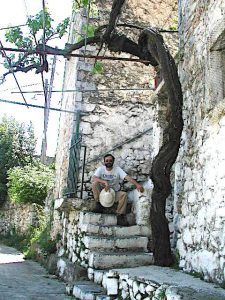
Green Deane with grapevine at his grandfather’s house in Karea, Greece, spring 2000.
Now it gets sticky: If you have a forked tendril, a thick grape leaf that’s hairy below (whitish short hairs, sometimes light brown, that resemble felt) wrinkled on top (think quilted mattress) a downward curve from the mid-rib and a large semi-sweet fruit, you are in the lower two-thirds of the state and your feet could be wet, you could have V. shuttleworthii, which perhaps a variation of V. aestavalis. If you live in Texas and think you have a V. shutteworthii but the grape tastes fiery pungent, you have V. candicans. Incidentally, V. shutteworthii is the direct ancestor of the cultivated “Stover” grape.
If you have a forked tendril, a thin flat leaf, smooth on top, but hairy below (rust-colored hairs that are NOT felt-like) and you are in New Jersey or below, you probably have V. aestivalis, which has at least four subspecies, V. sola, V. simpsonii, V. smallinana, and V. divegent. The V. aestivalis and V. simpsonii was used in the creation of the Lake Emerald and Norris varieties. The V. aestivalis is also in the ancestry of V. bourquiniana varieties of Herbemont and Lenoir.
If you have a forked tendril, the leaf is wrinkled dull green on top, white hairy below, branchlets look white or gray and the leaf base is deeply indented, and you are in the northwest portion of the state it could be V. cinerea. That is the most common grape in southeastern North America, excluding Florida.
To recap, if possible: If it is a grape with smooth bark, a round leaf, and probably toothy, with a single tendril, it is a muscadine, V. rotundiafolia to the north and west of the state, V. munsoniana to the middle and south. If you have all that and the mature bark is in strips or squares, it is V. vulpina.
If it has a forked tendril, the leaf is wrinkled on top and hairy underneath, and you are in the lower two thirds of the state and your feet are wet, it is probably V. shuttleworthii. If the leaf is smooth on top, hairy below, and has a forked tendril, and your feet are dry it is probably V. aestivalis. If it is wrinkled on top, hairy below, has a gray cast and you live in the western part of the state and north, it is V. cinerea. Whew!
If that is not confusing enough some argue the muscadines should not be in the Vitis genus at all and are rightfully the subgenus of Muscadinia because they have two less genes than other Vitis members. They would also make at least two more species in the subgenus. I should also mention that bringing into The South grape roots or plants from elsewhere will probably end in death. Pierce’s Disease is known to kill off at least 300 different species of grape.
One question I hear often is why aren’t the native grapes producing? They always seem not to have grapes. There are two answers: One is 90% of the vines have male flowers and all they do is basically lie around drinking sun all the time and belching oygen. And the gals? They fruit sporadically. However, the so-called non-native escaped cultivars produce almost every year.
As for pronunciation they are VEE-tiss (grape) row-tun-dee-FOH-lee-ah (roundleaf) es-tuh-VAL-uhs (of the field) sin-EER-ee-uh (the color of cinders, ashes) KAND-ik-anz, kan-DEEK-anz (white or wooly) vul-PEE-nah (fox) munso-nee-ANN-ah, simp-SON-ee-eye, bore-quin-nee-ANN-ah, ShuttleWORTH-ee-eye
Three tidbits:
- If you make grape jelly from muscadines don’t crush them bare handed or bare footed. The high acid content can lightly burn your hands or feet. Also, grape sap is drinkable.
- The grape vine, however, has a peculiar vascular arrangement. If you cut the vine it will not leak water unless you invert it. You can get a quart or more from a one-foot piece.
- In all English dialects except American English “vine” means the grape vine. In American English “vine” can mean many plants, not just the grape vine.
Green Deane’s “Itemized” Plant Profile
IDENTIFICATION: Grapes are woody vines with tendrils. Vines without tendrils that look like grapes are not grapes. The leaves vary greatly in shape from serrated and round to heart-shaped and smooth to lobed and hairy. The seeds of the grape are always tear-drop shaped. A grape-look alike is the moonseed which has seeds that are shaped like a crescent moon. Grapes in Florida tend to grow in clusters of two to 10, or bunches of 20 to 30 or more (not counting loss of numbers to birds and foraging humans.) Fruits are blue to black. There are hybrids under cultivation — some 300 different ones — that can be green, red, blue or black and are often very large.
TIME OF YEAR: Mid-summer to late fall in Florida, more towards fall as one goes farther north. Locally September first is a good date to aim for.
ENVIRONMENT: Grapes like full sun, good drainage and a healthy amount of water. But, they will survive in dry areas, putting on small fruit. They can even be found growing in Florida swamps, so they are very adaptable.
METHOD OF PREPARATION: Out of hand as they come off the vine. They can be made into jelly, jam, wine, raisins, fruit leather; the seeds can be pressed for oil and the young leaves boiled and eaten. The leaves of the hybrids are preferred to the muscadines. Muscadines can be high in acid so when crushing to make jelly don’t use your hand. Oh, and the seeds can be used to make grappa.

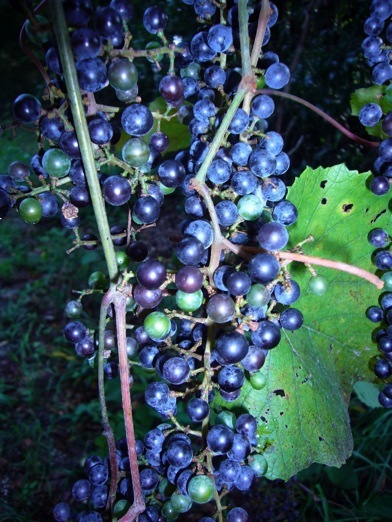
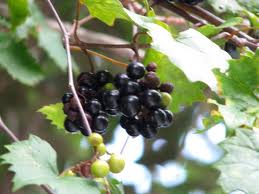
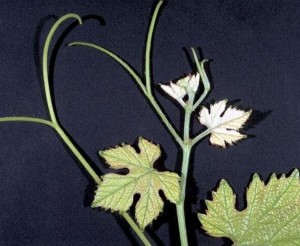
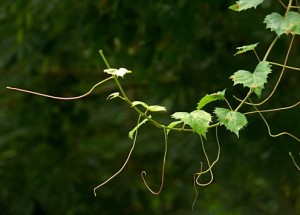

I love Grape Vine. Mostly Muscadine here. The leaves even taste like grapes. The grapes are on the sour side but good. I have never seen a poisonous Canadian Moonseed here but I think I would know by the tendrils growing around the stem and not outward or by the seed shape that it is not a Grape Vine.
It makes great woven baskets too. Just use the vine runners on and under the ground as they are better and more flexible than the above ground runners. There is a certain amount of shrinkage when the vine dries out so a tighter weave is better to account for any loosening.
Oh, and the larger Grape Vine trunks can yield a LOT of fresh clean and pure water. Cut a notch high to release the capillaries and then cut it low so it drips.
Great article.
Thanks
Tommy Smith
Wonderful site first off! Just read your article on grapes and have a few questions. A friend of mine has wild grapes growing on her land, what is the best way to get some started in my yard? We live in north Texas. The kind of grape she has makes good jelly she says but has too many seeds and thick skin so not good to eat off the vine. Would juicing get all (or most of) the nutrients out? I would like my 2 year old daughter to benefit from them also so looking for some healthy ideas. Thanks!!!
Juicing is good except you should extract the seeds first. Grapes are a long-term plant. In the ground today, fruiting several years from now.
I found vitus munsoniana in my neighborhood (Palm Bay) this AM. Nice ripe clusters of grapes. I will go back later to see if I can find enough to make something with…but I am a little confused, are the seeds safe to eat or grind up with the whole grape as in throw them into the vitamix blender and make a banana grape smoothie?
The seeds are pressed for their oil, and the mash used to make grappa. But they just don’t taste good. So while they won’t kill you in small quantities they are not pleasant tasting.
There’s a weed that looks just like a grapevine, but instead of grapes, clusters of some other purple berry, definately NOT grapes. Any ideas as to what it is? Might the leaves be edible?
Probably Virgina Creeper… the entire plant is toxic.
Here in Oklahoma I grow a heartleaf peppervine, Ampelopsis cordata, for foliage that is a grape look alike. It is a very vigorous growing vine here and covers my entire Airstream trailer.
The fruit is usually high in calcium oxalate which is toxic.
Your website is my absolute favorite hands down compared to everything! I just bought a beautiful 4 acre property in NW Gainesville FL and I’m SO enjoying identifying all of the beautiful, useful, and edible plants. I even have a fruiting grapevine which I assume from your article is probably V. munsoniana. I’ve also got beautiberries, plums, and lots of other fun edibles. I will be donating to your site veery soon for the wealth of knowledge you’ve provided for my new property! Thanks so much for all that you do!
I was out walking my friends dogs last week, found the wild grapes, they were mixed in with another vine, at first I was worried I would be collecting the wrong berry until I realized the other vine intermingled with the Wild Grapes, was not in fruit. I harvested 5 clusters. They are good, thick skins, light flavor big seeds for the fruit size and very refreshing. I cut some vines to propagate. I love this website and your videos, I wish you would come to Northern California just north of San Francisco. We have lots to check out here.
I would be interested to know how you propagate them. I haven’t had any luck.
As kids here in East Texas we ate mustang grapes until our mouths were too sore to eat more. Post oak and riverbank grapes are my favorites, other than muscadines. What else can you get foot and water from as well have a place to swing on?
My young imature clusters are going fuzzy. Shouldn’t the small grapes stay round and continue to grow. The fuzzy ones will not have grapes, with the exception of a few that didn’t go fuzzy. Fuzzy is what I call the little small hair like things that come out of the little grape that used to be a round little grape. After looking at my viens, I’m afraid there won’t be many grapes again this year. I have a white seedless and concord. The white is two years and concord is three. Thanks for any help.
You must prune them each year as they make best on the new growth. It’s a biblical principal to prune vines.
@Harold
My bet is that you’re seeing blooms, not little grapes. The buds look like grapes until they open and release pollen. Your plants are young… prune them well before they leaf out next spring (or late winter) and I’ll bet you get some fruit next year.
You should visit Pa where we have V. labrusca (very large and edible) , V argentifolia, (palatable) – V. Nova-Angelae (never found a fruit yet), V. riparia (abundant but bitter), V. cinerea (very sweet,small but rare). V. rupestris and baileyiana. (even more rare). We also have V.vulpina.
I have eaten V. rotundifolia but find the berry cover VERY tough.
Would you be willing to send me seeds of your southern grapes (well and properly identified) for a key to the SEEDS that I am attempting ???
I am also illustrating them !!!
My 13-month-old just swallowed the seeds whole from a muscadine vine around here in NE Alabama. Do I need to worry?
A grape seed? No.
Hi,
I was just out walking in the neighborhood here in mid Feb, just outside of Ft Myers, Fl. In a vacant lot I came across some patches of low growing vines, on the small side, not woody, that kind of look like a version of sprawling, anemic grape vines. No sign of fruit, but the leaves and unforked tendrils sure do resemble grapes, only so small compared to what I am familiar with. (The biggest leaves are maybe 3″) They grow over the scrub and ground in semi clearings between the mixed trees and shrubs, and don’t seem to run for very long. Any idea what I’m looking at?
Pictures help.
This was a great article, and I can now see why attempting identify a particular grape vine can be maddening!
Do you happen to know much about grapes in the northern states? I’m in Minnesota, and there is plenty of wild grape vine in my yard, but I’m not certain it’s worth trying to cultivate. Thoughts? It could be v. riparia?
How old is your grandfather’s grape vine in Greece?
Well over a century.
In that time period the state was making cultivars out of the wild grapes that produced more consistently and with better fruit. One still finds them now and then, as I did last week in Gainesville.
That sounds like scuppernongs. They are a variety of muscadine.
While searching for fruits on our property to make jellies, I found some ripened grape bunches, small fruit ( about the size of peas) ,black, very light sour flavor. Being excited, I kept looking, we have a lot of vines on our five acres. So I found another section about 75 ft away coming out of a shade hammock of some that had much larger fruits ,with a great flavor, surprisingly great actually, but only a few to the cluster. After reading this page, the larger ones should be V. shuttleworthii, but I live in palm coast/bunnell area. ALSO, from how you described the plants, they are single tendril, rounded, non fuzzy, toothed leaves. Seems like smooth bark, didn’t see anything that resembled how you described the others. I found more in the same area and the fruit clusters are from two to 13 per group of berries. They taste awesome! Still don’t have enough to make a jelly yet, but I have a couple days to find them.
I’m wondering what variety they are, and also how to get this cultivar to thrive and hopefully propagate. Are seeds a good way or can I make cuttings, and if so, how do I go about this?
In the past I’ve had muscadines and I just don’t like eating them. Mushy pulp, seems like no room for juice, strange unpleasant flavor ( not sour or sweet, just very unpleasant to me), big reddish fruit, so I am very pleased to find these growing.
Hi! Love your blog! I live in Palm Beach County and as a child would eat what my parents said were wild grapes. Have them in my yard and ate one (non-hairy, toothed leaves and single tendrils with pea-sized black fruits) and boy are they tannic! Are these actually grapes?
Could be, got a picture?
Our local super plentiful grape vines have leaves which are far too small to make dolmas, but I was wondering if anyone has tried fermenting them anyway? I was thinking of just packing then into a jar, fermenting and maybe making a layered version with the filling and cutting it into bite sized pieces? Not very traditional, but would taste the same! I was collecting some vines today to make wreaths, and stripping the vines, but saved the baby leaves because they looked kind of yummy, and have a big bowl full. I guess I have nothing to lose but some salt, right? LOL
I have discovered a literal 3 or 4 Acres of these on my property and lease area, here in Palm Bay Florida. I am going to try to send a couple of pictures. I would like to confirm these are in fact wild Florida grapes, “Muscadine ” Grapes. As I said there everywhere you look. However all the ground level up to about 4′ are all eaten by deer or what have you. but there is plenty over head
Do you know if it is safe to eat the unripe green grapes?
Hmmmm… fundamentally it is not unsafe but it will be astringent and not taste good and I would think at some point a lot of them would make you feel queezy.
Yes, green grapes are safe to eat.
They aren’t sweet, but the sour and astringent qualities can be balanced with spices and, I hear, make quite good pickles – well, India-style pickles, too spicy for me. Though it is true that one wouldn’t be eating these pickles in any great quantity, it is a strong pickle intended for flavoring other foods, a few teaspoons would flavor most meals.
Mom would always hunt the wild grapes because grocery grapes were not sold unripe, which was needed for these kinds of pickles – the spicy sour flavor profile works with unripe fruits quite well. And the unripe grape pickle was actually her favorite, and it was safe to eat like that – never had any problems.
Hello Green Deane! Love your work…
Can you tell me please if wild muscadine and/or grape leaves are edible? I’d like to make grape leaf dolmas, even if I can’t get muscadines out of them. Thanks a bunch! Happy foraging.
They are edible but they don’t taste good. Usually too bitter to use.